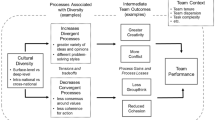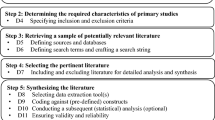Abstract
This paper provides an early attempt at operationalizing and testing the concept of knowledge strategy. Using a computer-simulated product development process, we compare the performance of generalist and specialist knowledge management strategies under conditions of market turbulence. The generalist knowledge strategy emphasizes breadth of knowledge in product development teams, while the specialist strategy focuses on depth of knowledge. Our generalist and specialist strategies are grounded in Eastern and Western perspectives of knowledge management, respectively. A primary difference between these two approaches is the strong emphasis on cross-learning, or learning across team members, in the Eastern perspective relative to the Western perspective. As such, we examine the performance implications of different modes of cross-learning for teams utilizing the generalist knowledge strategy. Specifically, we examine three modes of cross-learning, which are reflected in the use of three learning decision rules: (1) averaging, (2) majority, and (3) hot hand. A learning decision rule indicates how decision-makers learn from their fellow team members. Under the first rule, the decision-maker adopts an average of the beliefs held by fellow team members. Under the second rule, if a majority of fellow team members agree on a particular solution, then the decision-maker adopts the beliefs held by the majority. Under the third rule, the decision-maker learns from the team member whose beliefs have been consistent with market desires most recently. Surprisingly, we find that specialist strategies outperform generalist strategies under conditions of low and high market turbulence. We also find that cross-learning can be beneficial or detrimental, contingent upon the mode of learning. Generalist teams utilizing the averaging decision rule perform significantly worse, while generalist teams utilizing the hot hand decision rule perform significantly better.
Similar content being viewed by others
References
Ashby, W.R. (1956), An Introduction to Cybernetics. Wiley, New York.
Axelrod, R. (1997), “Advancing the Art of Simulation in the Social Sciences,” Presented at the International Conference on Computer Simulation and the Social Sciences (Cortona, Italy, September 22–25).
Baldwin, C.Y. and K.B. Clark (2000), Design Rules: The Power of Modularity, Vol. 1. MIT Press, Cambridge.
Baum, J.A.C. (1999), “Organizational Ecology,” in S. R. Clegg and C. Hardy (Eds.) Studying Organization, Sage Publications, London, pp. 71–108.
Besen, S.M. and J. Farrell (1994), “Choosing howto Compete—Strategies and Tactics in Standardization,” Journal of Economic Perspectives, 8(2), 117–131.
Bower, G.H. and E.R. Hilgard (1981), Theories of Learning. Prentice-Hall, Englewood Cliffs, NJ.
Brown, S.L. and K.M. Eisenhardt (1997), “The Art of Continuous Change: Linking Complexity Theory and Time-Paced Evolution in Relentlessly Shifting Organizations,” Administrative Science Quarterly, 42(1), 1–34.
Burns, T. and G.M. Stalker (1961), The Management of Innovation. Tavistock Publications Limited, London.
Burton, R.M. and B. Obel (1995), “The Validity of Computational Models in Organization Science: From Model Realism to Purpose of the Model,” Computational and Mathematical Organization Theory, 1(1), 57–71.
Carley, K. (1992), “Organizational Learning and Personnel Turnover,” Organization Science, 3, 20–46.
Carley, K.M. (1995), “Computational and Mathematical Organization Theory: Perspectives and Directions,” Computational and Mathematical Organization Theory, 1(1), 39–56.
Carley, K.M. and J. Lee (1998), “Dynamic Organizations: Organizational Adaptation in a Changing Environment” in J. Baum (Ed.) Advances in Strategic Management, Vol. 15, JAI Press, London, pp. 269–297.
Carley, K.M. and Z. Lin (1997), “A Theoretical Study of Organizational Performance Under Information Distortion,” Management Science, 43(7), 976–997.
Christensen, C.M. (1992), The Innovator's Challenge: Understanding the Influence of Market Environment on Processes of Technology Development in the Rigid Disk Drive Industry, DBA Dissertation, Graduate School of Business Administration, Harvard University.
Christensen, C.M. (1997), The Innovator's Dilemma: When New Technologies Cause Great Firms to Fail. Harvard Business School Press, Boston.
Cohen, D. (1998), “Toward a Knowledge Context: Report on the First Annual U. C. Berkeley Forum on Knowledge and the Firm,” California Management Review, 40, 22–39.
Daft, R. and K. Weick (1984), “Toward a Model of Organizations as Interpretation Systems,” Academy of Management Review, 9(2), 284–295.
Donaldson, L. (1999), “The Normal Science of Structural Contingency Theory,” in S.R. Clegg and C. Hardy (Eds.) Studying Organization, Sage Publications, London, pp. 51–70.
Dougherty, D. (1992), “Interpretive Barriers to Successful Product Innovation in Large Firms,” Organization Science, 3(2), 179–202.
Gersick, C.J.G. (1988), “Time and Transition in Work Teams: Toward a New Model of Group Development,” Academy of Management Journal, 31(1), 9–41.
Gersick, C.J.G. (1991), “Revolutionary Change Theories:AMulti-Level Exploration of the Punctuated Equilibrium Paradigm,” Academy of Management Review, 16(1), 10–36.
Gigone, D. and R. Hastie (1993), “The Common Knowledge Effect: Information Sharing and Group Judgment,” Journal of Personality and Social Psychology, 65, 959–974.
Gilovich, T., R. Vallone and A. Tversky (1985), “The Hot Hand in Basketball: On the Misperception of Random Sequences,” Cognitive Psychology, 17, 295–314.
Grant, R.M. (1996), “Toward a Knowledge-Based Theory of the Firm,” Strategic Management Journal, 17, 109–122.
Griffin, A. and J.R. Hauser (1996), “Integrating R&D and Marketing: A Review and Analysis of the Literature,” Journal of Product Innovation Management, 13, 191–215.
Hambrick, D.C. (1983), “High Profit Strategies in Mature Capital Goods Industries: A Contingency Approach,” Academy of Management Journal, 26(4), 687–707.
Hannan, M.T. and J. Freeman (1977), “The Population Ecology of Organizations,” American Journal of Sociology, 82, 929–964.
Hannan, M.T. and J. Freeman (1989), Organizational Ecology. Harvard University Press, Cambridge.
Holloman, C.R. and H.W. Hendrick (1972), “Adequacy of Group Decisions as a Function of the Decision-Making Process,” Academy of Management Journal, 15(2), 175–184.
Iansiti, M. (1993), “Real-world R&D: Jumping the Product Generation Gap,” Harvard Business Review, 71(3), 138–147.
Ilgen, D.R., D.A. Major, J.R. Hollenbeck and D.J. Sego (1995), “Raising an Individual Decision-Making Model to the Team Level: A New Research Model and Paradigm,” in R.A. Guzzo, E. Salas and Associates (Eds.) Team Effectiveness and Decision Making in Organizations, Josey-Bass Publishers, San Francisco, pp. 113–148.
Imai, K., I. Nonaka and H. Takeuchi (1985), “Managing the New Product Development Process: How Japanese Companies Learn and Unlearn,” in K.B. Clark, R.H. Hayes and C. Lorenz (Eds.) The Uneasy Alliance: Managing the Productivity-Technology Dilemma, Harvard Business School Press, Boston, pp. 337–375.
Lawrence, P.R. and J.W. Lorsch (1967), Organization and Environment. Division of Research, Graduate School of Business Administration, Harvard University, Boston.
Leonard, D. (1995), Wellsprings of Knowledge. Harvard Business School Press, Boston.
Levinthal, D. and J.G. March (1981), “AModel of Adaptive Organizational Search,” Journal of Economic Behavior and Organization, 2(4), 307–333.
Levinthal, D.A. and J.G. March (1993), “The Myopia of Learning,” Strategic Management Journal, 14, 95–112.
Lin, Z. and K.M. Carley (1997), “Organizational Response: The Cost PerformanceTradeoff,”Management Science, 43(2), 217–234.
Madhavan, R. and R. Grover (1998), “From Embedded Knowledge to Embodied Knowledge: New Product Development as Knowledge Management,” Journal of Marketing, 62, 1–12.
March, J.G. (1991), “Exploration and Exploitation in Organizational Learning,” Organization Science, 2, 71–87.
March, J.G. and H. Simon (1958), Organizations. Wiley, New York.
McGrath, J.E. (1982), “Dilemmatics: The Study of Research Choices and Dilemmas,” in J.E. McGrath, J. Martin and R.A. Kulka (Eds.) Judgment Calls in Research, Sage Publications, Beverly Hills, pp. 69–102.
Miller, J.H. (1998), “Active Nonlinear Tests (ANTs) of Complex Simulation Models,” Management Science, 44(6), 820–830.
Nonaka, I. (1990), “Redundant, Overlapping Organization: A Japanese Approach to Managing the Innovation Process,” California Management Review, 32(3), 27–38.
Nonaka, I. and H. Takeuchi (1995), The Knowledge-Creating Company. Oxford University Press, New York.
Norman, P.M. and R.A. Bettis (1997), “Technological Complexity and the New Architecture of Competition,” in H. Thomas, D. O'Neal and R. Alvarado (Eds.) Strategic Discovery: Competing in New Arenas, JohnWiley and Sons, New York, pp. 5–22.
Rulke, D.L. and J. Galaskiewicz (2000), “Distribution of Knowledge, Group Network Structure, and Group Performance,” Management Science, 46(5), 612–625.
Sanchez, R. and J.T. Mahoney (1996), “Modularity, Flexibility, and Knowledge Management in Product and Organization Design,” Strategic Management Journal, 17, 63–76.
Sastry, M.A. (1997), “Problems and Paradoxes in a Model of Punctuated Organizational Change,” Administrative Science Quarterly, 42, 237–275.
Shukla, R.K. (1982), “Influence of Power Bases in Organizational Decision Making: A Contingency Model,” Decision Sciences, 13(3), 450–470.
Simon, H.A. (1997), Administrative Behavior. Free Press, New York.
Spender, J.-C. and R.M. Grant (1996), “Knowledge and the Firm: Overview,” Strategic Management Journal, 17, 5–9.
Sun Tzu (1963), The Art of War. translation by S.B. Griffith, Oxford University Press, London.
von Hippel, E. (1990), “Task Partitioning: An Innovation Process Variable,” Research Policy, 19, 407–418.
Williamson, O.E. (1975), Markets and Hierarchies. Free Press, New York.
Wittenbaum, G.M. and G. Stasser (1996), “Management of Information in Small Groups,” in J.L. Nye and A.M. Brower (Eds.) What's Social About Social Cognition?, Sage Publications, Thousand Oaks, pp. 3–28.
Wooldridge, B. and S.W. Floyd (1990), “The Strategy Process, Middle Management Involvement, and Organizational Performance,” Strategic Management Journal, 11(3), 231–241.
Author information
Authors and Affiliations
Rights and permissions
About this article
Cite this article
Turner, S.F., Bettis, R.A. & Burton, R.M. Exploring Depth Versus Breadth in Knowledge Management Strategies. Computational & Mathematical Organization Theory 8, 49–73 (2002). https://doi.org/10.1023/A:1015180220717
Issue Date:
DOI: https://doi.org/10.1023/A:1015180220717




